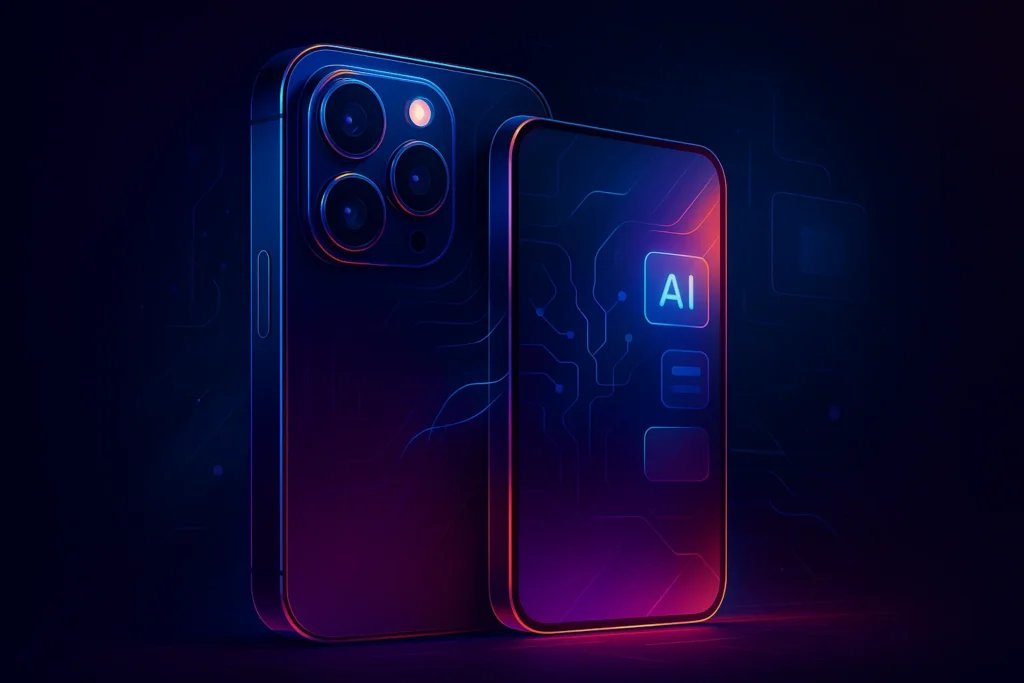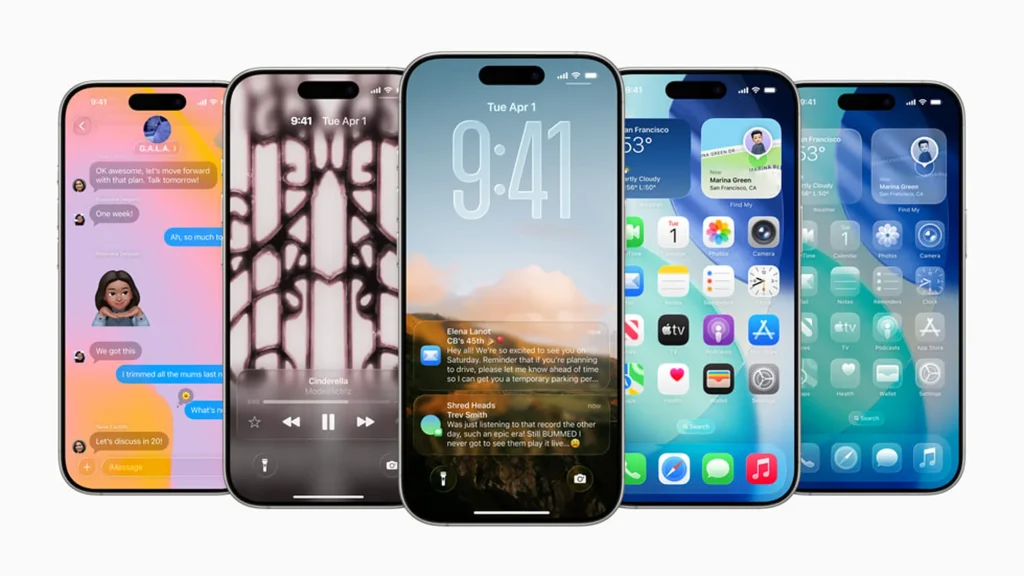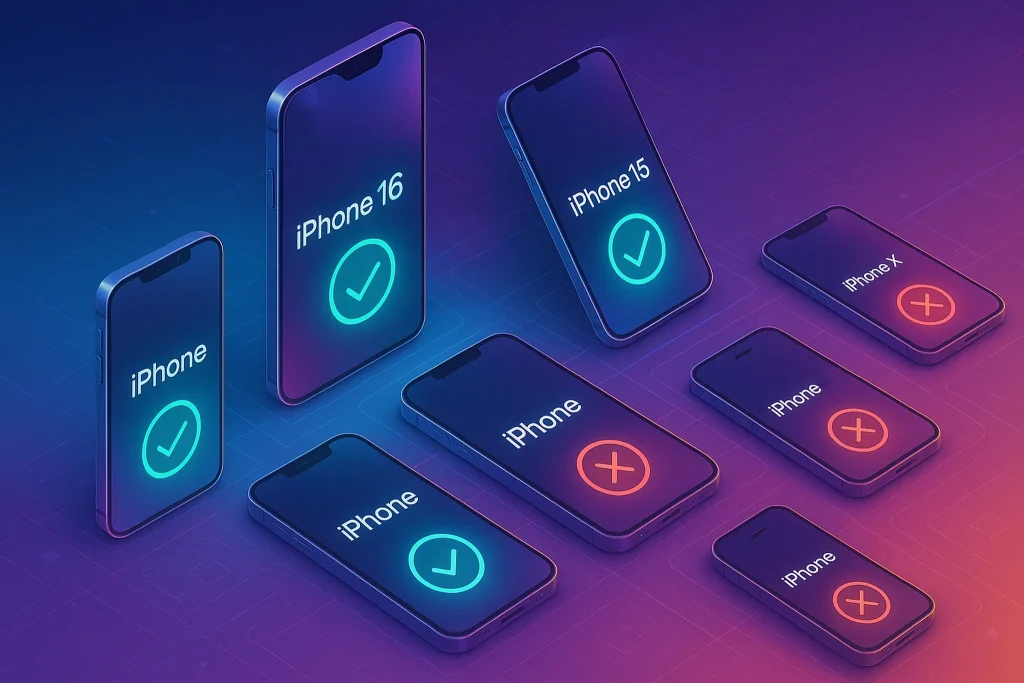Introduction: iPhone 16 Pro as Apple’s AI Statement
Apple’s annual September keynote in 2025 wasn’t just another hardware refresh. The launch of the iPhone 16 Pro marked Apple’s loudest declaration yet that we’ve entered the AI-first smartphone era. With competitors like Samsung’s Galaxy S25 Ultra and Google’s Pixel 10 betting heavily on generative AI, Apple had to prove its vision of “Apple Intelligence” wasn’t just buzzwords.
The iPhone 16 Pro is the result: an elegant fusion of cutting-edge silicon, a polished design, and deeply integrated AI features running on iOS 26’s Liquid Glass update. From real-time photo retouching to smarter Siri-driven workflows, Apple isn’t simply keeping up—it’s redefining what premium looks like.
💡 This isn’t just an incremental iPhone—it’s Apple’s play to prove it can lead in the AI revolution, not just follow.
Design and Display: Subtle Evolution, Big Payoff
At first glance, the iPhone 16 Pro doesn’t look drastically different from its predecessor. But Apple has doubled down on Liquid Retina XDR 2.0 with higher brightness, improved energy efficiency, and support for adaptive refresh rates up to 144Hz—finally catching up with the smoothness competitive gamers crave.
The body features titanium edges refined for lighter weight, continuing the design language introduced with iPhone 15 Pro but polishing it further. Bezels shrink once again, making the 6.3-inch and 6.9-inch Pro models feel compact despite their immersive screens.
For creatives, Apple introduced a NanoTexture matte option, reducing glare for outdoor use without compromising sharpness—ideal for photographers, designers, and professionals on the move.
Performance: A18 Pro Bionic and On-Device AI
Powering the iPhone 16 Pro is the new A18 Pro Bionic chip, built on a 2nm process. Beyond the raw speed, the star is its AI-optimized Neural Engine, delivering up to 50 trillion operations per second. That’s not just marketing—it allows Apple Intelligence features to run entirely on-device for privacy and latency advantages.
Workflows like real-time video transcription, context-aware Siri shortcuts, and adaptive app memory allocation all run seamlessly. Unlike earlier generations where Siri felt like an add-on, this version feels like a genuine AI assistant.
👉 Want context on how Apple compares? Our review of the Samsung Galaxy S25 Ultra explores Samsung’s AI ambitions—and how Apple’s A18 Pro stacks up.
Camera: From Photography to Cinematography
Apple has always treated the camera as the iPhone’s centerpiece, and the iPhone 16 Pro pushes boundaries further.
-
A 48MP primary sensor with improved low-light performance.
-
A new 120mm telephoto zoom exclusive to the Pro Max model, rivaling DSLR-level clarity.
-
AI-assisted features like Scene Builder, which auto-suggests cinematic framing, and Smart Retouch, removing distractions or re-lighting faces in real-time.
Where Apple really differentiates is video: Dynamic Cinematic Mode 2.0 enables real-time 4K/120fps recording with AI-driven focus pulling. This isn’t just a smartphone camera anymore—it’s a professional video tool.
For creators and pros, iPhone 16 Pro may now be enough to replace dedicated gear.
iOS 26 and Liquid Glass: The Software Shift
Hardware matters, but software sells experiences. iOS 26, dubbed “Liquid Glass,” introduces a fluid, adaptive interface that reacts to context. Widgets resize dynamically, background tasks flow seamlessly between apps, and personalization feels more alive than static icons ever could.
Paired with Apple Intelligence, Liquid Glass makes multitasking effortless. Drafting an email while referencing a calendar event? iOS now suggests context-aware actions like attaching meeting notes or auto-generating summaries.
👉 For a deeper look at Apple’s software shift, read our breakdown of the Apple iOS 26 ‘Liquid Glass’ Update.
Want More Apple Launch Insights?
Join our free newsletter for weekly updates on Apple, Google, and Samsung launches plus hands-on reviews and AI tech deep-dives.
No spam. Just sharp insights.
100% privacy. No noise. Just premium tech content from NerdChips.
🎨 iPhone 16 Pro vs. Rivals
| Feature | iPhone 16 Pro | Galaxy S25 Ultra | Pixel 10 |
|---|---|---|---|
| AI Integration | Apple Intelligence | Samsung Gauss AI | Gemini Native AI |
| Display | 144Hz XDR 2.0 | 2000-nit AMOLED | 120Hz OLED Adaptive |
| Camera Highlight | 120mm Telephoto | 200MP sensor | Adaptive Cinematic |
| Chipset | A18 Pro Bionic | Snapdragon Elite Gen 3 | Tensor G4 |
| OS Experience | iOS 26 Liquid Glass | OneUI 7 | Gemini-embedded Android |
📌 Apple may not chase raw megapixels, but its secret weapon is polish—hardware and software designed in unison.
🎨 Checklist: What’s New in iPhone 16 Pro
-
✅ A18 Pro chip with 50 TOPS Neural Engine for on-device AI.
-
✅ Liquid Glass iOS 26 with adaptive multitasking.
-
✅ 48MP primary + 120mm telephoto on Pro Max.
-
✅ Dynamic Cinematic Mode 2.0 with real-time 4K/120fps.
-
✅ NanoTexture matte finish for glare reduction.
Pricing & Availability
The iPhone 16 Pro starts at $1,099, while the Pro Max variant begins at $1,199. Storage tiers range from 256GB up to 2TB, ensuring options for power users. Pre-orders opened immediately after the keynote, with availability in the U.S., Europe, and major Asian markets by late September 2025.
Interestingly, Apple also teased a trade-in boost program, offering higher values for older Pro models to encourage upgrades—a nod to users still holding on to the iPhone 14 Pro. If you’re on the fence, our feature Is the iPhone 14 Pro Still Worth It in 2025? is worth reading before making a move.
Ecosystem Expansion: Apple Watch Ultra 2 and Beyond
Apple didn’t stop with the phone. The keynote also spotlighted the Apple Watch Ultra 2, now with advanced running metrics and AI-driven training plans, clearly targeting athletes. Pairing the 16 Pro with the Ultra 2 creates a seamless fitness and productivity ecosystem.
AirPods also saw incremental upgrades, including spatial audio with adaptive head tracking, proving Apple’s commitment to a connected suite of products that make each device more valuable together.
👉 Curious how the Ultra stacks up? Check our Apple Watch Ultra 2 Review for Runners.
Market Impact: The AI Smartphone Race
The iPhone 16 Pro doesn’t exist in a vacuum. With Google’s Pixel 10 launch and Samsung’s Galaxy S25 Ultra already pushing AI boundaries, Apple’s choice to keep everything tightly integrated into iOS shows its strategy: polished experiences over experimental ones.
This controlled approach appeals to Apple’s core audience—those who value reliability, privacy, and ecosystem harmony. But it also raises the question: will Apple’s conservative pace let rivals seize the innovation narrative, or will the iPhone’s polish keep it dominant?
User Scenarios: Who Really Benefits from iPhone 16 Pro?
Not every iPhone release is meant for every type of user. With the iPhone 16 Pro, Apple has clearly targeted audiences who demand AI-driven workflows, next-gen photography, and ecosystem harmony.
-
Creators and Filmmakers: Dynamic Cinematic Mode 2.0 and the 120mm telephoto lens make the iPhone 16 Pro a serious contender to replace semi-pro gear. Video bloggers, YouTubers, and mobile filmmakers stand to gain the most.
-
Business Professionals: With AI-powered transcription, context-aware email drafting, and Liquid Glass multitasking, this phone can easily replace a laptop for everyday work scenarios.
-
Students and Knowledge Workers: Real-time summarization and AI-driven study aids transform the iPhone into a pocket research assistant, cutting study time significantly.
-
Mobile Gamers: The 144Hz display and A18 Pro GPU optimizations mean smoother gameplay with lower latency, appealing to esports enthusiasts.
On the other hand, casual users who primarily use their phones for social media, calls, and light gaming may not fully justify the $1,099+ price tag. For them, Apple’s mid-range lineup remains sufficient.
Sustainability & Environmental Angle
Apple has been consistent in marketing its green credentials, and the iPhone 16 Pro continues this tradition. The device uses 100% recycled aluminum in its chassis, and rare earth elements in magnets and circuitry are now largely reclaimed. Packaging has been further minimized with fully recyclable, plastic-free materials.
More importantly, the A18 Pro’s AI-powered energy optimization isn’t just about speed—it’s about efficiency. Apple claims the iPhone 16 Pro achieves up to 20% longer battery life per watt-hour, effectively reducing the carbon footprint of charging cycles.
Yet, skepticism remains. Some critics argue that Apple’s yearly refresh cycle itself undermines sustainability goals by encouraging consumer churn. Still, compared to competitors, Apple’s balance of efficiency, recycled materials, and renewable energy in supply chains sets an industry benchmark.
💡 If environmental impact is part of your buying decision, the iPhone 16 Pro represents one of the most eco-conscious flagships available in 2025.
Comparison with iPhone 14 Pro Owners
For those holding onto the iPhone 14 Pro, the question isn’t just “what’s new?” but “is it worth upgrading?”
-
Performance: The jump from A16 to A18 Pro is massive in AI processing, but for everyday tasks, the 14 Pro is still lightning fast.
-
Camera: The 14 Pro introduced 48MP sensors, but the 16 Pro’s 120mm telephoto and cinematic upgrades offer tangible benefits for photographers and video creators.
-
Software: iOS 26 rolls out to iPhone 14 Pro as well, but AI features are limited since they’re optimized for A17/A18 chips. This means you’ll miss out on real-time AI workflows.
-
Battery & Efficiency: The 16 Pro lasts noticeably longer due to its AI-optimized performance cores.
👉 If you’re weighing the upgrade, check our detailed feature: Is the iPhone 14 Pro Still Worth It in 2025?. In short: unless you’re a creator or heavy professional user, the 14 Pro still holds its ground.
Connectivity & 6G Preparations
The iPhone 16 Pro isn’t just about today—it’s quietly preparing for tomorrow. Alongside Wi-Fi 7 support for ultra-fast local connectivity, Apple has introduced 6G-ready antennas that future-proof the device for the next wave of global mobile networks. While 6G won’t be mainstream until late this decade, Apple is signaling that this phone won’t be outdated in a couple of years.
This matters especially for global travelers and digital nomads. High-bandwidth, low-latency networks like 6G will unlock near-instant cloud gaming, immersive AR experiences, and new collaboration tools. By building in the hardware now, Apple ensures longevity—making the iPhone 16 Pro a safer long-term investment compared to rivals focusing only on present-day 5G optimization.
Global Pricing & Market Strategy
Apple’s global strategy is as important as the device itself. Pricing for the iPhone 16 Pro varies significantly by region:
-
United States: Starts at $1,099 (Pro) / $1,199 (Pro Max).
-
Europe (Germany, France, UK): €1,299–€1,399, reflecting higher VAT and regulatory costs.
-
Middle East: Roughly $1,250, with premium positioning targeting affluent buyers.
-
India & Emerging Markets: Apple continues its staggered rollout with financing options, making the device accessible in smaller payment cycles.
Apple’s regional trade-in programs are particularly aggressive this year, offering up to $500 credit for older Pro models. Combined with installment financing, this lowers the barrier to upgrade and helps Apple expand its high-end market share.
This strategic pricing contrasts with Google’s Pixel 10, which undercuts Apple in affordability, and Samsung’s Galaxy S25 Ultra, which leans toward premium positioning.
Future Outlook: Where Apple Goes from Here
The iPhone 16 Pro is more than a device—it’s a signal of Apple’s trajectory. By doubling down on AI, sustainability, and future-proof connectivity, Apple is making clear that its ambitions extend beyond the smartphone.
Looking ahead, Apple is rumored to be exploring foldable iPhone prototypes, set to challenge Samsung’s Z series dominance. The company is also pushing aggressively into AR and wearable ecosystems, suggesting a future where iPhones integrate seamlessly with AR glasses, watches, and beyond.
Apple’s endgame? Transforming the iPhone from a standalone product into the hub of an intelligent, sustainable, and globally connected ecosystem.
💡 If iPhone 16 Pro is Apple’s AI flagship, iPhone 17 or a foldable model may redefine what the word “iPhone” even means in the next five years.
🧠 Nerd Verdict
The iPhone 16 Pro isn’t just another iterative launch—it’s Apple’s strongest step into the AI era. With the A18 Pro, Liquid Glass, and next-gen camera tools, Apple proves it can blend futuristic capability with the brand’s trademark reliability.
Where competitors experiment, Apple refines. And for millions of users, that’s exactly the reassurance they want in a $1,000+ device.
❓ FAQ: Nerds Ask, We Answer
💬 Would You Bite?
Do you think Apple’s AI-first iPhone 16 Pro is enough to keep it ahead of Google and Samsung, or should Apple take bigger risks in innovation?



